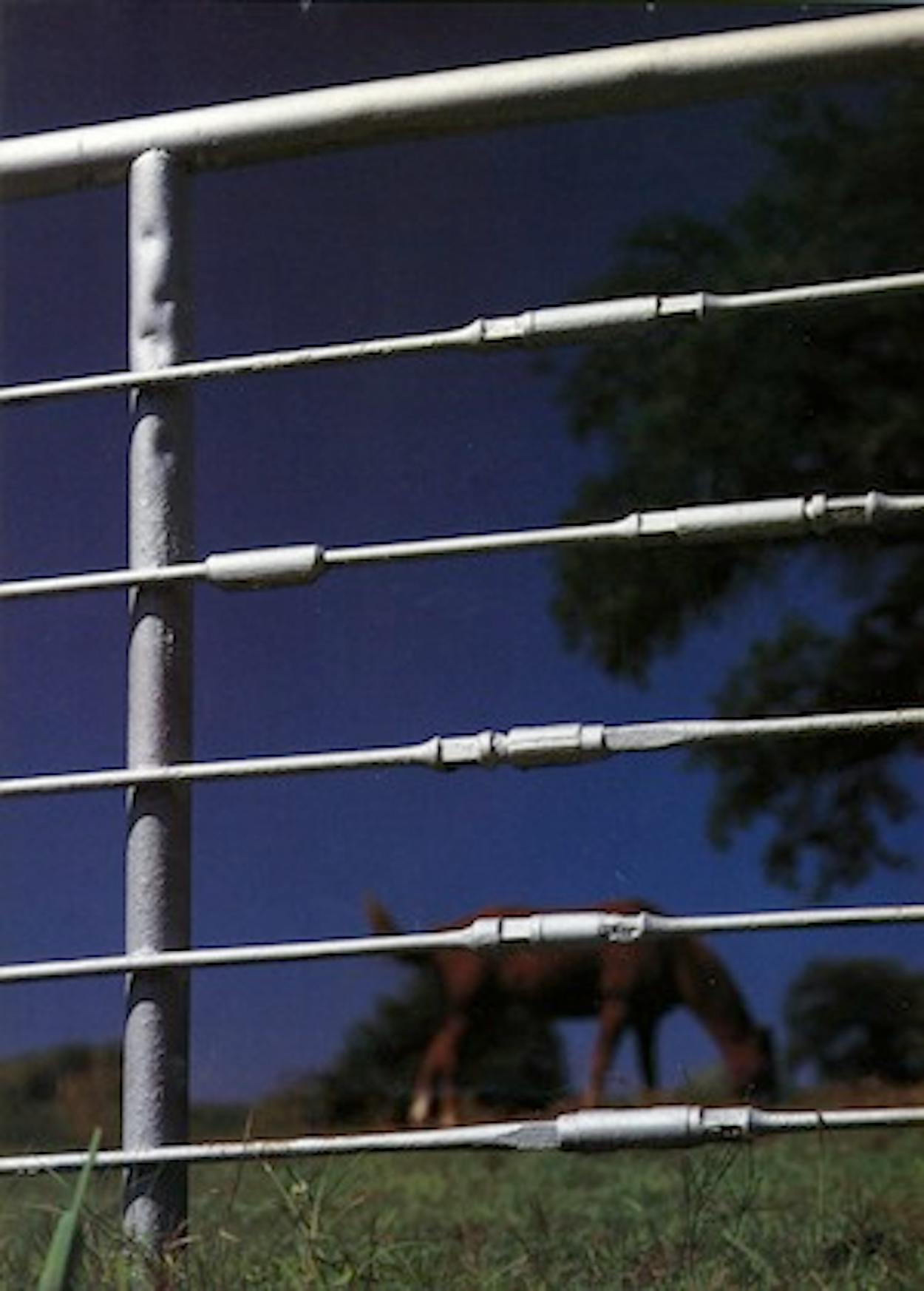You’ve seen one, whether you know it or not, usually enclosing a pasture of good green grass, with placidly grazing horses and a palatial ranch house in the distance. The posts and the top rails of the fence are made of steel pipe, called drill stem, and the lower rails are made of steel rods, called sucker rods. You see these fences all over Texas, from Borger to Beaumont, but especially near oil fields. The pipe and the rod are oil-field surplus, one of the great recyclable natural resources of Texas. Of course, old cowboys say the best fence is none at all, but if you have to have a fence—and in a land crisscrossed by freeways, you do—this one is the choice, for more reasons than you can shake a sucker rod at.
The drill-stem fence, also called a pipe fence, is primarily for horses, because a high-strung horse can injure himself on barbed wire. Also, the horse business is mainly show business nowadays, and the horseman wants his ranch to make a good impression. The drill-stem fence does that. Freshly painted, running straight and strong, it radiates stability and integrity. And money. Now, in Maryland and Kentucky, horse raisers accomplish the same result with those neat white wooden fences. Their fields are a pretty sight, no question, and with next year’s Derby contenders behind them, the fences are a source of pride for those folks. But the truth is, their fences aren’t the best ones. Ours are.
Obviously, a drill-stem fence is plenty strong. Hollis Jones, of Wise County, who runs buffalo on a section of his ranch, says stampeding bison make no dent in it. Even the sturdiest wooden fence is not as strong and not nearly as durable, simply because rot proceeds faster than rust and nails don’t last as long as welding. Animals can’t chew up a drill-stem fence, and as for maintenance, there is practically none except occasional painting—and an unskilled worker can paint half a mile of it a day with a simple paint glove. One other thing: The drill-stem fence is hospitable—it’s a good fence that makes good neighbors. Your animals stay in, and at the same time your friends can cross it without tearing their new jackets or pulling the staples loose from your fence posts.
So now you’re convinced, right, and you want a drill-stem fence on your little ranch. Where do you get one? Well, first you need to know something else: These fences are not made with real drill stem. To quote Robert Brown, a former tool pusher for Gage and Moore, of Fort Worth, “A drill-stem fence? What do you got—elephants? Man, drill stem weighs two hundred pounds a foot. They call it drill stem, but what they use in them fences and barns and metal buildings is tubing.” Whatever it’s called, its fundamental purpose is to drill oil wells. The drill stem, which is about 4 inches in diameter, makes the hole; another pipe, called casing, sets the hole; the tubing, 2 3/8 inches or slightly larger in diameter, goes inside the casing; and the sucker rod works up and down inside the tubing to pump the oil or gas out. Never mind if you didn’t get all that; just order tubing when you build your fence.
The going price today for good tubing—new, but with holes or other blemishes that disqualify it by strict oil-field standards, which allow nothing but perfection in a hole that costs so much—is 50 cents a foot. That’s cheap, but by the time you buy your sucker rods and hire an unemployed pipeline welder working cheap to build it for you, drill-stem fence will run you as much as a good wooden fence. Even the big boys can’t afford to use it on the entire spread. The vast 6666 ranch in northwest Texas, for instance, is one of the last ranches in Texas where cowboys work exclusively on horseback, and the 6666 uses smooth wire without barbs most places and uses pipe for building corral fences.
Now that you’ve read this, you’ll start noticing plenty of drill-stem fences, and some of them may even have little crowns welded on top of some posts to seal the open end. Those bristling pieces of metal are used drill bits. The crown motif is not a necessary part of the fence, but it does lend a suitably regal touch. Next time you drive past a drill-stem sucker rod fence, consider its strength, its handsome practicality, and the symbiosis between oil and ranching that it represents. You’ve seen Giant. What kind of a fence do you think would look right on Reata?
- More About:
- Energy







